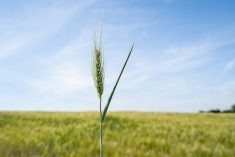Depending on the textbook you read and the plant you are growing it takes from 16 to 20 chemical elements to grow a crop. And, a nutrient required in even the most minute quantity can put the lid on yield just as much as a nitrogen deficiency.
In Henry’s Handbook of Soils and Crops I wrote, “I do not suffer under any delusion that we have discovered all the micronutrient deficiencies that exist in Western Canada. … Micronutrient research is expensive and often not exciting because a lot of ‘nothing’ results are obtained.”
Read Also

Claas brings 1000 Series SP forage harvesters to Canada
In mid-August, Claas unveiled its new line of Jaguar forage harvesters at an event in Visalia, California, deep in the heart of that state’s dairy region.
In past Grainews articles I have also said “If you have to pick a lot of stones it is not likely you will have a micronutrient deficiency.” The rationale is that soils mixed up and deposited by glaciers will have a little bit of everything. The water-laid deposits separate out various size fractions and in the process a crucial nutrient may be in short supply.
So far I have had no one give me any meaningful data to refute that statement. Maybe this time someone will. If any reader has valid experiments over years and locations that show that statement to be false I will be most delighted to eat crow and learn in the process.
Pet micronutrients
Micronutrients have “pet” soils and “pet” crops. For copper, wheat is the pet crop and pet soils are peat and high organic matter sandy soils. And, for copper there is a well-established set of soil test benchmarks based on enough field experiments to be useful. In Western Canada, copper is the micronutrient most likely to be used with good economic benefit on soils that are deficient.
Oats is the pet crop for manganese and peat soils are the soils that may be deficient, but documented responses are few. In Tanzania we had a wheat variety and volcanic ash soil that would grow nothing without manganese fertilizer — but that was a very special case. In that case it was a special new variety that exhibited the manganese problem. That variety had done well in tests on other soils that were not manganese deficient.
Beans are the pet crop for zinc, and high pH and high lime soils are the most probable soils. Very high rates of broadcast phosphorus fertilizer used to raise soil test phosphorus can induce a zinc deficiency. That happened on the clay soils of the University of Saskatchewan Kernen farm.
CCA and P.Ag types who want to check it out can go to: J. P. Singh, R. E. Karamanos,and J. W. B. Stewart. 1986. Phosphorus-induced Zinc Deficiency in Wheat on Residual Phosphorus Plots. Agronomy Journal: Volume 78, pages 668-675. In that study the highest rates of phosphorus fertilizer used were 700 pounds acre of 0-46-0 (Triple Super Phosphate). But, apart from that case, documented responses to Zinc are few.
Boron deficiencies with alfalfa on sandy grey soils have been shown, but they are not widespread.
Iron has been a problem with some shrubs and fruit trees on high pH, high lime soils, particularly very fine textured soils.
Zinc and iron
On a global basis, for human nutrition iron and zinc are the major problems and some countries have many zinc-deficient soils. Plant breeders are working on varieties that have higher levels of zinc to improve the nutritional value in areas where that nutrient is limiting.
For iron deficiencies in Africa, a unique solution was to provide folks with a $5 “Lucky Iron Fish” that could be put in the cooking pot to provide iron for a family for five years. (You can read more about this in the May 24 issue of The Globe and Mail.) Seems like a very sensible solution to me.
With the high annual crop yields we’ve been growing the past many years it is reasonable to suspect that more cases of micronutrient deficiencies will develop. But, specialty N/P/K/S fertilizers that have a small quantity of a micronutrient may not provide any benefit and should be priced on a comparison of the cost of the actual macronutrients. If the actual cost for the micronutrient is high, there should be some reasonable expectation of a positive return to warrant the expense. At $8 wheat and $15 canola the extra cost may be of no consequence but we are back in a situation where pencils have to be sharpened again. At the same time we must continue to be on the lookout for new situations where a micronutrient may be of economic benefit.
Caveat Emptor/buyer beware.
















